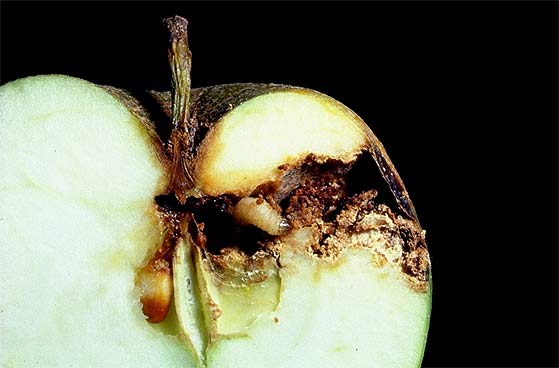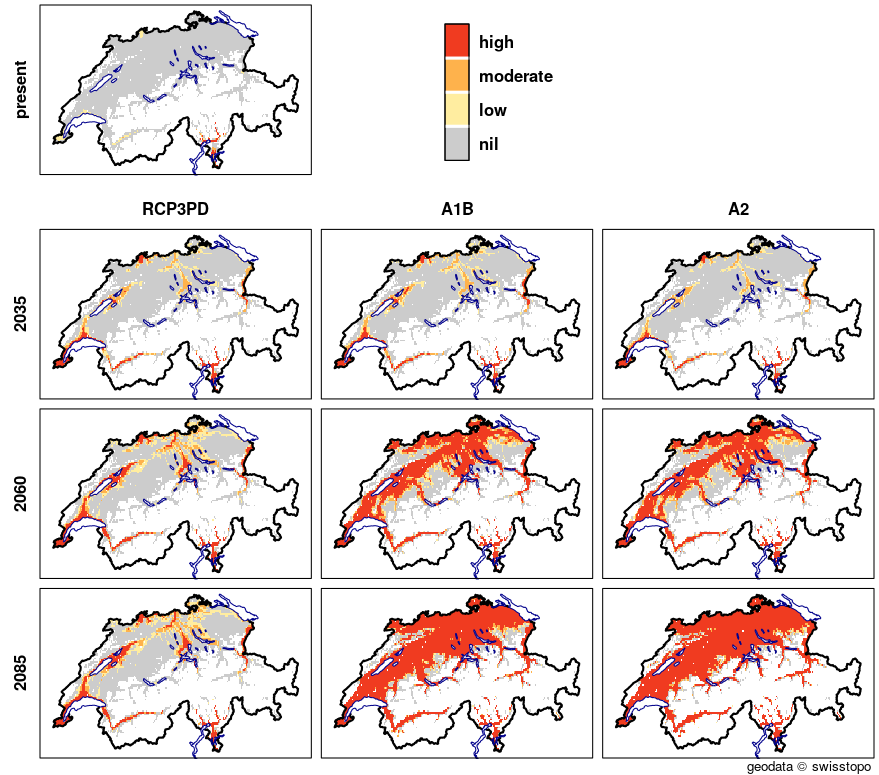The codling moth (Cydia pomonella) is considered to be one of the key pests in fruit production. The larva causes damage by boring into the apple (Fig. 1). Under current climatic conditions, one grub generation per year is observed in northern Switzerland. By contrast, two grub generations per year always appear in southern Switzerland. In warmer years, a second generation is possible in northern Switzerland, whilst a third grub generation may actually develop in southern Switzerland (Fig. 2).

© Agroscope
Studies have shown that climate change will lead to an earlier start to the flight period of the overwintering generation, and to an even earlier occurrence of the subsequent stages of development (Stöckli et al., 2012). What’s more, data from warmer regions indicate that through natural adaptation to higher temperatures, the codling moth may go into the dormant stage later (Hirschi et al., 2012, Stoeckli et al., 2012). All this increases the likelihood that in future, the codling moth will more often develop two to three generations a year in northern Switzerland, and three generations a year in southern Switzerland (CH2014). This must be borne in mind when adapting control strategies (Stoeckli et al., 2012).
The regions in which, in the future, a third generation of grubs is likely to occur will enclose the Swiss Central Plateau, the Three-Lakes Region, the region around Lake Geneva, and the Rhine Valley, even under the assumption of a climate-stabilising emission scenario (RCP3PD; Fig. 2). With the assumption of emission scenarios that do not provide for any mitigating intervention, the potential distribution range of a third generation of grubs becomes significantly larger, encompassing the whole of Switzerland’s fruit-growing area (A1B and A2).
Whether a third generation of codling moths can actually cause damage, however, depends on whether the grubs of this generation still find apples on the trees that they might attack. Ultimately, therefore, the phenological development of the host plant determines the effective risk of infestation; and this varies greatly depending on whether the apple varieties potentially affected are early- or late-ripening ones.
Results of more-recent analyses, for instance, show that nowadays in southern Switzerland, the likelihood of damage from a third generation of codling moth grubs exceeds 50% only in the case of the late-ripening variety Golden Delicious, whilst the probability for the earlier-ripening apple variety Gala stands at only around 10%. In future, the likelihood of an infestation by a third generation of grubs will increase for both apple varieties, but will remain lower for Gala than for Golden Delicious.
For the very-early-ripening Gravenstein variety, which nowadays is grown almost exclusively in northern Switzerland, the probability of damage by a third generation of codling moth grubs remains negligible, even up to the end of the current century. This underscores the future role of the variety selection and breeding to reduce the potential for damage by insects. Research aimed at this is carried out inter alia by Agroscope and the FiBL.
Additional Information
Literature
References Cited in the text
Hirschi, M., Stoeckli, S., Dubrovsky, M., Spirig, C., Calanca, P., Rotach, M. W., Fischer, A. M., Duffy, B. and Samietz, J., 2012: Downscaling climate change scenarios for apple pest and disease modeling in Switzerland, Earth Syst. Dynam., 3(1), 33–47.
Stoeckli, S., Hirschi, M., Spirig, C., Calanca, P., Rotach, M. W. and Samietz, J. 2012: Impact of climate change on voltinism and prospective diapause induction of a global pest insect – Cydia pomonella (L.), PLoS ONE, 7(4), e35723.
Stöckli, S., Samietz, J., Hirschi, M., Spirig, C., Rotach, M. und Calanca, P., 2012: Einfluss der Klimaänderung auf den Apfelwickler, Schweizer Zeitschrift für Obst- und Weinbau, 19.
Additional reading
CH2014-Impacts, 2014: Towards quantitative scenarios of climate change impacts in Switzerland, herausgegeben von OCCR, FOEN, MeteoSwiss, C2SM, Agroscope und ProClim, Bern, Schweiz, 136 pp.
Felber, R., Stöckli, S., Calanca, P., 2018: Generic calibration of a simple model of diurnal temperature variations for spatial analysis of accumulated degree-days, Int. J. Biometeorol., 62, 621–630.
Harshman, J. M., Evans, K. M. and Hardner, C. M., 2016: Cost and accuracy of advanced breeding trial designs in apple, Hortic. Res., 3(1), 1–10.
Hirschi, M., Spirig, C., Weigel, A. P., Calanca, P., Samietz, J. and Rotach, M. W., 2012: Monthly weather forecasts in a pest forecasting context: Downscaling, recalibration, and skill improvement, J. Appl. Meteorol. Clim., 51(9), 1633–1638.
Samietz, J., Graf, B., Höhn, H., Schaub, L. and Höpli, H. U., 2008: Schädlingsprognose für den Obstbau, AGRARForschung, Forschungsanstalt Agroscope Changins-Wädenswil ACW, Wädenswil, Schweiz.
Samietz, J., Graf, B., Razavi, E., Höpli, H. U., Höhn, H. and Schaub, L., 2011: Web-based decision support for sustainable pest management in fruit orchards: Development of the Swiss system SOPRA, INTECH Open Access Publisher.
Samietz, J., Stoeckli, S., Hirschi, M., Spirig, C., Höhn, H., Calanca, P. and Rotach, M., 2015: Modelling the impact of climate change on sustainable management of the codling moth (Cydia pomonella) as key pest in apple, in Acta Horticulturae, pp. 35–42, International Society for Horticultural Science (ISHS), Leuven, Belgien.
Last modification 25.09.2023







